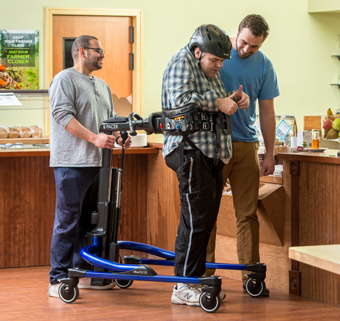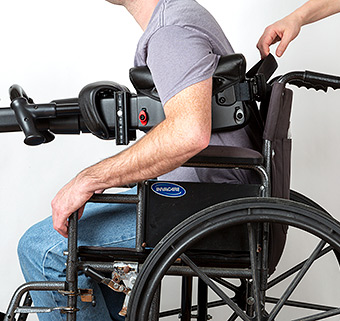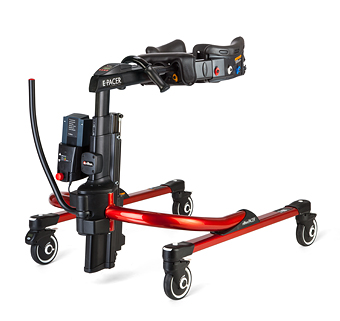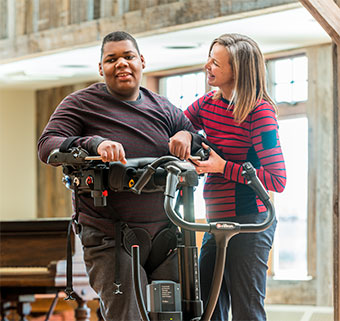Patient Transfer and Lifting Guidelines Implications for Pediatric Physical Therapists
| August 2011 Techniques for lifting and transferring patients are among the most basic skills physical therapists learn. Many of us were taught that by use of appropriate body mechanics we could transfer patients safely and effectively without risk of injury to us or the patient.1 In reality, however, even physical therapists who are well trained in the biomechanics of lifting experience occupational injury2-5 or at least spinal loading forces during patient care tasks that exceed acceptable limits.6 Training is not always effective. 7 This is where the use of appropriate equipment can make a big difference. Waters suggests that patient transferring/lifting equipment be used to minimize work load for therapists. 8 But hurdles still remain. When training caregivers, we encounter people who do not want to use devices because they are cumbersome, require too much energy to use, or because storage space or acquisition costs are prohibitive. Finally, some equipment is simply too complicated and impractical for daily clinical use.
Techniques for lifting and transferring patients are among the most basic skills physical therapists learn. Many of us were taught that by use of appropriate body mechanics we could transfer patients safely and effectively without risk of injury to us or the patient.1 In reality, however, even physical therapists who are well trained in the biomechanics of lifting experience occupational injury2-5 or at least spinal loading forces during patient care tasks that exceed acceptable limits.6 Training is not always effective. 7 This is where the use of appropriate equipment can make a big difference. Waters suggests that patient transferring/lifting equipment be used to minimize work load for therapists. 8 But hurdles still remain. When training caregivers, we encounter people who do not want to use devices because they are cumbersome, require too much energy to use, or because storage space or acquisition costs are prohibitive. Finally, some equipment is simply too complicated and impractical for daily clinical use.
Safe Lifting Procedures Put Into Practice
Currently, the National Institute for Occupational Safety and Health (NIOSH) recommends a maximum weight lift for patient-handling tasks of 35 pounds.1,9,10 In a systematic review by Wai, et al, there was an association between sick leave due to low back pain and lifts of 22 pounds or more, and an association between chronic low back pain and patient lifts of greater than 55 pounds.11 Supporters contend that the 35 pound weight limit is acceptable if the conditions are right: the caregiver has sufficient strength to lift the patient, the patient is compliant, the task is straight forward, and the estimated amount lifted is accurate.10 We know that in practice, the patient transfer from the wheelchair to the bed rarely meets these criteria.
The personal and financial cost of musculoskeletal disorders is staggering.1,10 Nurses experience an alarmingly high rate of workplace injuries. As a result we are seeing new legislation and new guidelines emerge. Legislation regarding safe lifting procedures has passed in eleven states and has been proposed in ten additional states. At the federal level HR 2381: Nurse and Health Care Worker Protection Act of 2009 was introduced that year, though it never passed into law. 1, 12 With the support of physical therapists, many hospitals and skilled nursing facilities are now implementing “no lift” policies—suggesting that no patient transfer is safe.1 The Occupational Health and Safety Administration (OSHA) has published a safe lifting guideline for nursing homes, “Ergonomics for the Prevention of Musculoskeletal Disorders.” They recommend that “lifting should be minimized in all cases and eliminated when feasible;” and that this recommendation should be used in “other similar settings.”9 Cost-benefit analysis demonstrates that the costs of using patient lifting equipment offsets the costs of musculoskeletal disorders 1,9 and the attendant worker’s compensation claims.
 When we consider that a lift of greater than 35 pounds puts undue strain on the body, it obliges us to consider the occupational demands of our job. We need to assess the rate of occupational injury in our setting and advocate for safe patient handling practices, which should include eliminating and/or minimizing lifting. When making recommendations for transfer/lifting tasks, we need to consider the frequency demands and energy expenditure of caregivers. Consider what you can do in your practice:
When we consider that a lift of greater than 35 pounds puts undue strain on the body, it obliges us to consider the occupational demands of our job. We need to assess the rate of occupational injury in our setting and advocate for safe patient handling practices, which should include eliminating and/or minimizing lifting. When making recommendations for transfer/lifting tasks, we need to consider the frequency demands and energy expenditure of caregivers. Consider what you can do in your practice:
- Educate caregivers about safe patient lifting procedures and minimizing the work load.
- Task analyze the demands of your job: consider how often you lift, bend, move your patients and what equipment might be useful to minimize your work load. This may include a 2nd person to assist with a transfer, use of a mechanical lift to put a student on an adaptive tricycle or use of a Rifton E-Pacer as a partial weight-bearing device.
- Task analyze the demands of caregivers. Consider minimizing the number of transfers per day for dependent students and advocate for patient lifting equipment in the school, home and community settings of the patients you work with. Cite the research and NIOSH standards in your DME justification.
- Consider use of DME equipment for alternative purposes such as use of a gait trainer without the hip positioner for diapering or use of a stander in a horizontal position as a sidelying positioner or for diapering.
As practitioners in the continuum of care, pediatric physical therapists are in a unique position to advocate for safe patient transfer techniques. We, as advocates for families and children, need to promote the use of devices that will decrease caregiver injury and promote optimal health for the children and families we work with.
References:1. Campo M, Rockefeller, K, Harwood, K. (2009). Body Mechanics is not enough. From: Combined Sections Meeting, American Physical Therapy Association , Feb 11,2009;Las Vegas,NV.
2. Campo M, Weiser S, Koenig KL, Nordin M. Work-related musculoskeletal disorders in physical therapists: A prospective cohort study with 1-year follow-up.
Phys Ther 2008;88:608-619. Accessed March 7, 2009.3. Cromie JE, Robertson VJ, Best MO. Work-related musculoskeletal disorders and the culture of physical therapy.
Phys Ther 2002;82:459-472. Accessed March 7, 2009.4. Holder NL, Clark HA, DiBlasio JM, Hughes CL, Scherpf JW, Harding L, Shepard KF. Cause, prevalence, and response to occupational musculoskeletal injuries reported by physical therapists and physical therapist assistants.
Phys Ther1999;79:642-652.5. King P, Huddleston W, Darragh AR. Work-related musculoskeletal disorders and injuries: differences among older and younger occupational and physical therapists.
J Occup Rehabil. 2009;19:274-283.6. Marras WS, Davis KG,KirkingBC,Bertsche PK.A comprehensive analysis of low-back disorder risk and spinal loading during the transferring and repositioning of patients using different techniques. Ergonomics 1999;42(7):904-926.
7. Nielsen D, Sigurdsson SO, Austin J. Preventing back injuries in hospital settings: the effects of video modeling on safe patient lifting by nurses. J Applied Behav Anal.2009;42(3):551-561.
8. Waters TR, Rockefeller K. Safe patient handling for rehabilitation professionals. Rehabil Nurs. 2010;35(5):216-222.
9. Occupational Health and Safety Administration. Guidelines for Nursing Homes. Ergonomics for the prevention of musculoskeletal disorders. Accessed on March 7, 2009 at http://osha.gov/ergonomics/guidelines/nursinghome/final_nh_guidelines.pdf.
10. Waters TR. When is it safe to manually lift a patient? Am J Nurs 2007;107(8):53-58.
11. Wai EK, Roffey DM, Bishop P, Kwon BK, Dagenais S. Causal assessment of occupational lifting and low back pain: results of a systematic review. Spine J.2010;10:554-566.
12. Motacki K, Motacki LM. Safe patient handling and movement in a pediatric setting. Ped Nurs. 2009;35(4): 221-225.




